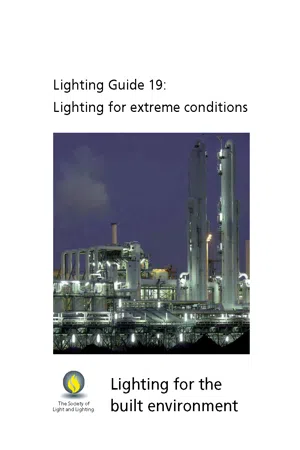
- English
- PDF
- Available on iOS & Android
Lighting Guide 19: Lighting for extreme conditions
About this book
There are so many different types of both buildings and industries in this modernage that it is sometimes difficult to envisage what may be classed as a 'normal' working environment. Each of these different types will have different requirements peculiar to each use. However, there are many installations where extra care must be taken when it comes to the choice of luminaire, due to either abnormal or extreme conditions within the working area. This Lighting Guide is therefore divided into sections describing most of the arduous environments that the lighting designer or specifier is likely to come across on a daily basis. Eachsection will then consider some applications or types of area peculiar to that extreme type of environment. The list is not exhaustive, and reference should be made, in many cases, to the manufacturer of the luminaire, rather than the application itself. An extreme condition has been taken to mean a building or a particular room within a building or, indeed, an external area, where people carry out any activity in conditions that could be harmful to either the safety of the individuals or the luminaires providing the artificial lighting, or where processes produce such conditions. Associated areas within these buildings, such as offices, corridors and storage areas, are not considered in this Guide, unless the hazardous or extreme conditions prevail there also. Light is necessary for one to see, and as many workplaces are used at night as well as during the day, a system of artificial lighting is required to either replace or supplement the available daylight.There are, of course, many working areas where more than one extreme condition is present, and it is advised that all relevant sections are studied together so that a lighting solution can be found which will function correctly. In such cases it may be necessary to take the most arduous requirements and apply the recommendations accordingly. If there is a particular use that cannot be found in his Guide, then advice must be sought from a qualified body such as the Health and Safety Executive or the Fire and Rescue Service, who have specialist officers dealing with most eventualities. However, a good place to start would be the luminaire manufacturer.Lighting, as used in all extreme conditions, has four objectives: — to enable workers in the area to see what they are doing— to enable them to see what is happening around them— to contribute to the safety of everyone within the room or building— to create a good visual environment.With these objectives in mind, the several parts of this Lighting Guide have been compiled.It must be stressed that it is as important to apply the correct colour and form of lighting if it is to accurately achieve a specified illuminance. Light itself cannot be seen until it strikes an object, which then appears to be lit. The success of an installation should not be judged by light meters but through the eyes of those who have to work in that environment. Similarly, efficiency should not be rated simply by the effectiveness of gathering all the lamp lumens and exclusively directing them onto the task plane, but rather by the ease with which the task canbe seen and by the contribution of the lighting installation to making the environment more agreeable. The latter suggestion may be difficult to achieve in some extreme environments.The reader is urged to read through the whole of this Guide and not simply to turn to the references for a particular type of area or situation. Throughout the text, successful lighting techniques are discussed. Learn to analyse the visual task and the lighting problem. If members of the workforce prefer to be in one particular area think why and build on it. If certain parts of the room or area appear better with the aid of daylight try to understand why.
Frequently asked questions
- Essential is ideal for learners and professionals who enjoy exploring a wide range of subjects. Access the Essential Library with 800,000+ trusted titles and best-sellers across business, personal growth, and the humanities. Includes unlimited reading time and Standard Read Aloud voice.
- Complete: Perfect for advanced learners and researchers needing full, unrestricted access. Unlock 1.4M+ books across hundreds of subjects, including academic and specialized titles. The Complete Plan also includes advanced features like Premium Read Aloud and Research Assistant.
Please note we cannot support devices running on iOS 13 and Android 7 or earlier. Learn more about using the app.
Information
Table of contents
- 1 Introduction
- 2 Lighting considerations
- 3. Recommendations
- 4. Remote lighting techniques
- 5. Emergency lighting
- 6. Lamp performance charts
- 7. Lighting design